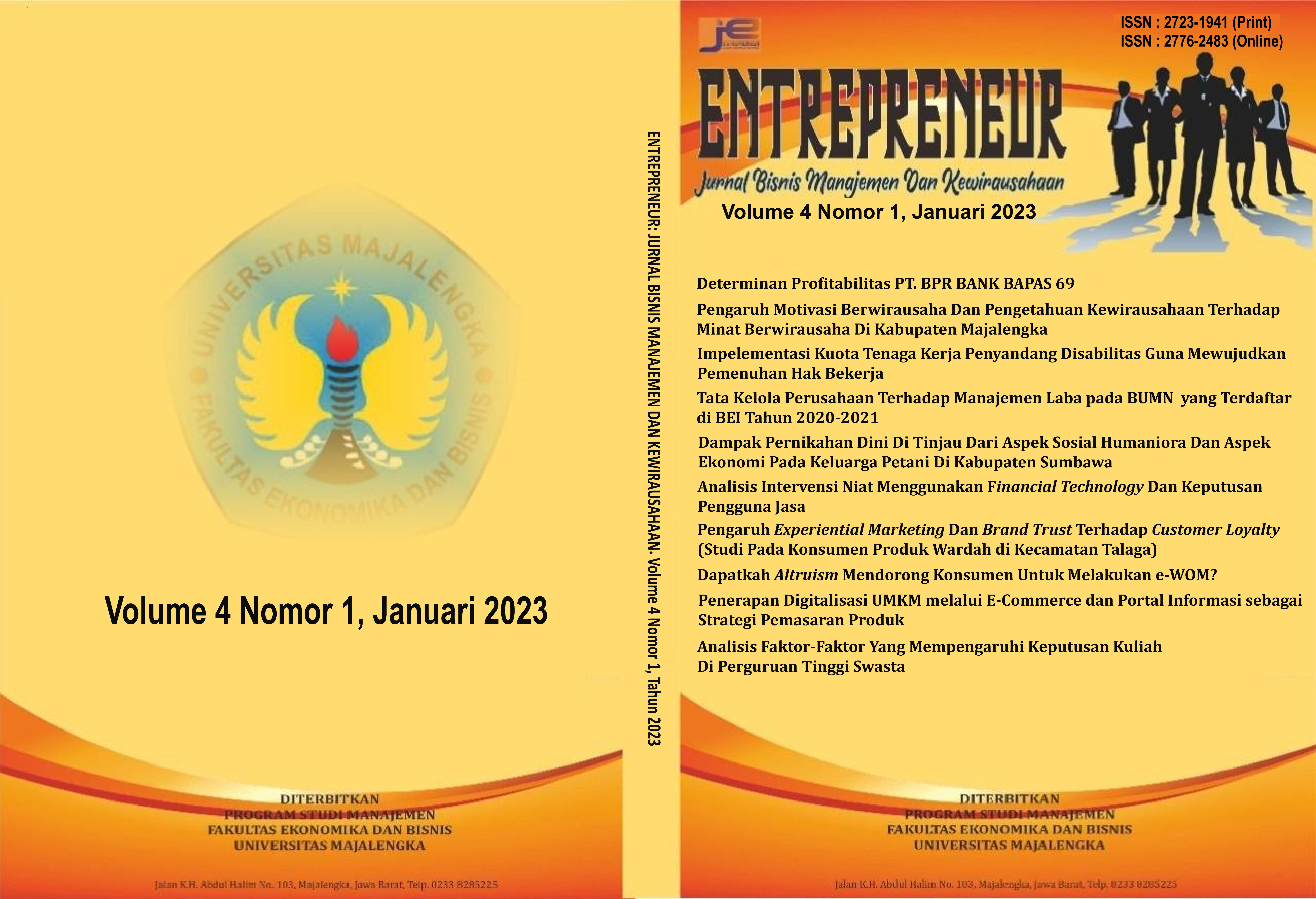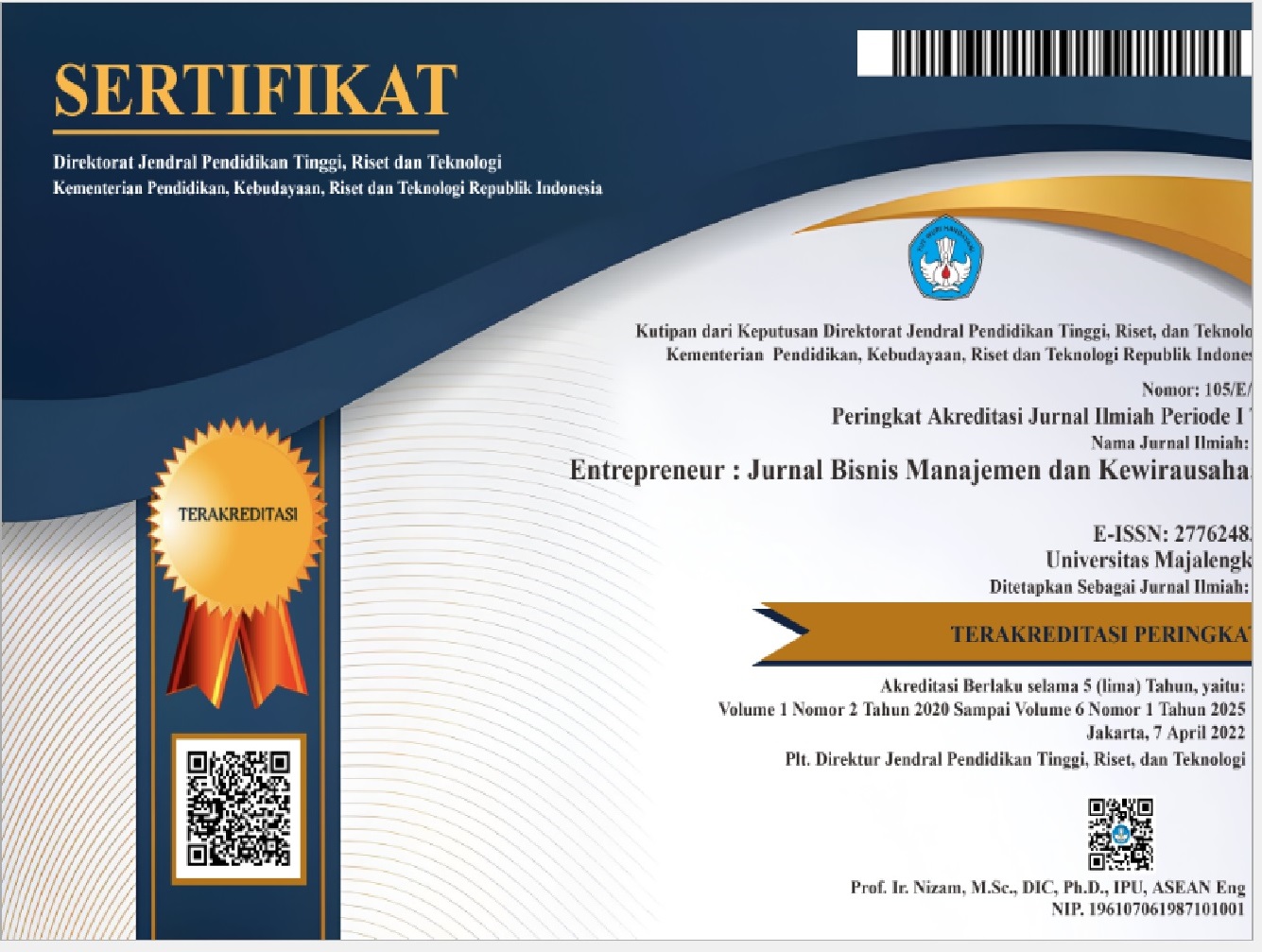Strategi Pemasaran Produk Baru (Studi Kasus Puding Lamota)
DOI:
https://doi.org/10.31949/entrepreneur.v4i1.3449Abstract
New products include new-to-the-world products that create new markets, minor product developments, or revisions to existing products. Sales of products, especially new products, require future-oriented marketing. Therefore the company must have a good marketing strategy for each new product that is produced where the strategy needs to be planned by taking into account the determinants of the success of new products on the market. Several new product marketing strategies, namely the S–O Strategy based on strength and opportunity considerations, consist of strategies prioritizing product quality, online marketing (online marketing), online competition, discounts, and giveaways. The W–O strategy is based on consideration of weaknesses and opportunities, consisting of market analysis strategies, attractive packaging, reviews or testimonials, and collaboration with business partners. The S–T strategy is based on consideration of strengths and challenges, consisting of strategies to maintain product quality and taste, maintain affordable product prices, and seek alternative quality raw materials when raw material prices rise. The W–T strategy is based on the consideration of weaknesses and challenges, consisting of research and development strategies, patenting product names, excellent service, and product evaluation.
Keywords:
Produk Baru; Strategi Pemasaran; Analisis SWOT.Downloads
References
Ferdinand, Augusty. (2015). Metode Penelitian Manajemen. Semarang: Badan Penerbit Universitas Diponegoro.
Kotler, Philip dan Keller, K. L. (2009). Marketing Management. 13th Edition. New Jersey: Pearson Education.
Nengsih. (2012). Strategi Pemasaran Produk Baru Recipes Mobile Application PT. Agranet Multicitra Siberkom (Agrakom) Periode Juli 2011 – Juni 2012. Journal of Management and Business Review, Vol. 9 No. 2, July 2012, hlm. 154-157.
Rangkuti, Freddy. (2017). Analisis SWOT Teknik Membedah Kasus Bisnis. Jakarta: Gramedia Putaka Utama.
Sarita, Maulinda & Suprianto. (2022). Analisis Strategi Bisnis Dalam Meningkatkan Daya Saing Pada Lapak Taman Genang Genis Sumbawa Besar. Samalewa: Jurnal Riset dan Kajian Manajemen. Volume 2 Nomor 1, Juni 2022, hlm. 50-58.
Sarjono, Bambang. (2015). Strategi Pemasaran Produk Baru. Orbith, Vol. 11 No. 3, November 2015, hlm. 230 – 236.
Sucihati, Roos Nana, Suprianto, Marisa Sutanty, Wahyu Haryadi, & Ismawati. (2021). Penyuluhan dan Pelatihan Labeling, Packaging, dan Marketing Untuk Meningkatkan Penjualan Produk UMKM di Kabupaten Sumbawa. Jurnal Pengembangan Masyarakat Lokal, Vol. 4 Issue 2, 2021, hlm. 277-282.
Sunyoto, Danang. (2014). Dasar-dasar Manajemem Pemasaran: Konsep, Strategi dan Kasus. Yogyakarta: CAPS (Center of Academic Publishing Service).
Tjiptono, Fandy. (2014). Pemasaran Jasa: Prinsip, Penerapan, Penelitian. Yogyakarta: Penerbit Andi.
Walidah, Ziyana, Eva Aulina Wardani, Ayu Risky Wulandari, Faradilla Putri Mahendra, Ria Setya Ningtyas, Deltaningtyas Tri Cahyaningrum. (2021). Penerapan Analisis SWOT terhadap Strategi Pemasaran Pie Susu Zingiberaceae saat Pandemi Covid-19. Jurnal Manjemen Agribisnis Dan Agroindustri, Vol. 1 No. 1, June 2021, hlm. 52-59. DOI: 10.25047/jmaa.v1i1.9
Winahyu, Windu Mukti, Efendi Tjendera, Reuben E. Gutierrez, Jimmy Sadeli. (2008). Perencanaan Strategi Pemasaran Dalam Peluncuran Produk Baru Dengan Merek “EXO COFFEE” pada PT. Jamu Puspo Internusa. Journal of Business Strategy and Execution, Vol. 1 No.1, November 2008, hlm. 158-170.

Published
How to Cite
Issue
Section
License
Copyright (c) 2023 Suprianto Naim, Hasdita Elies Ramadani, Elisa Juniarti, Mia Maelani, Elliza Rizki Wandani, Elsa Rahmawati

This work is licensed under a Creative Commons Attribution-ShareAlike 4.0 International License.
COPYRIGHT NOTICE
An author who publishes in the Entrepreneur: Jurnal Bisnis Manajemen dan Kewirausahaan agrees to the following terms:
1. Author retains the copyright and grants the journal the right of first publication of the work simultaneously licensed under the Creative Commons Attribution-ShareAlike 4.0 License that allows others to share the work with an acknowledgment of the work's authorship and initial publication in this journal
2. The author is able to enter into separate, additional contractual arrangements for the non-exclusive distribution of the journal's published version of the work (e.g., post it to an institutional repository or publish it in a book) with the acknowledgment of its initial publication in this journal.
3. The author is permitted and encouraged to post his/her work online (e.g., in institutional repositories or on their website) prior to and during the submission process, as it can lead to productive exchanges, as well as earlier and greater citation of the published work







